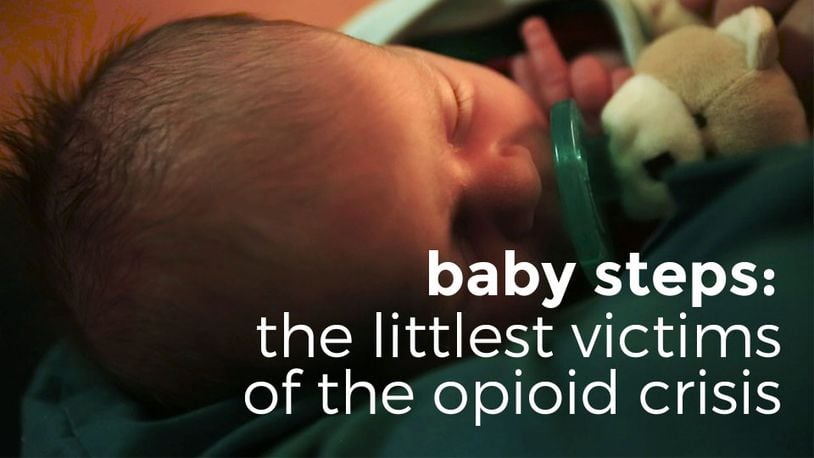While the care any baby receives in an NICU will be world-class, it is not really the best environment for infants in withdrawal, according to doctors.
“The NICU is a completely appropriate environment for sick newborns,” says Dr. Sean Loudin, medical director of Lily’s Place and the Neonatal Therapeutic Unit (NTU) at Cabell Huntington Hospital in Huntington, West Virginia. “But there’s lots of lights and alarms and activity and things, which is potentially not the correct therapeutic environment for babies who are going through NAS.”
Babies in withdrawal have a lot of sensory issues, so fluorescent hospital lighting and beeping monitors aren't helpful for their recoveries. Even in the specialized NTU at the local hospital, babies are often three or four to a room. At Lily's Place, however, each child gets their own room, and the environment can be tailored to exactly what is needed at any time. Nurse-to-patient ratios are very low by design.
“We also are able to provide that environment to where it’s easier for the parents to sit and rock their baby and bond with their baby, because they’re the only one in there with their baby, not sharing a room with two or three other families,” says Rebecca Crowder, the executive director of Lily’s Place.
Treatment started in the hospital continues seamlessly at Lily’s Place, which uses the same medical protocols and medications as the hospital, Sean says.
Read more about Lily’s Place and Brigid’s Path: Two centers of hope open for opioid-exposed babies
Babies who were exposed to drugs in the womb are essentially detoxing cold turkey, starting the minute they’re born.
In many ways, it's the same experience an adult would go through. But these infants have never known anything else, nor can they tell their nurses and parents what they need or where it hurts.
Some of the hallmark symptoms of NAS include tremors — uncontrollable “fine little shakes” — and a distinctive, high-pitched, inconsolable cry. Patients often have increased muscle tone and are rigid all the time, so when lifted, their heads do not fall back the way other babies’ do. Difficulty feeding, elevated temperature, sneezing fits, yawning, sweating, diarrhea, vomiting and trouble sleeping are all warning signs for doctors and nurses in the newborn nursery.
If a baby is known to have possible opioid exposure, the length, severity and frequency of their symptoms are measured and meticulously charted. The most common assessment is the Finnegan Neonatal Abstinence Scoring System (FNASS), which assigns a numerical score based on more than 20 physical symptoms. The score helps establish and guide treatment, including helping to determine whether drugs are necessary, and if so, which ones and what doses.
Many hospitals are moving away from morphine as a treatment drug for these patients, favoring methadone or buprenorphine instead. The opiate weaning process works for the vast majority of exposed infants, Sean says. Babies are usually in the clear after six months, though symptoms can last from weeks to months, depending on the infant’s exposure levels and which substances they’ve been exposed to.
Just figuring that out is a challenge, too.
“Over half of our infants are exposed to more than one substance,” Sean says. “To be honest, a lot of women sometimes don’t know what they have taken, because they don’t know the things that have been mixed in with their heroin, their exposure to fentanyl, other benzodiazepines and neuro-acting substances. Sometimes they are simply unaware of those medications.”
The puzzle gets harder as other synthetic or modified opiates come onto the scene. While doctors do plenty of drug testing, formulas are changing too rapidly for tests to keep up. Identifying those exposures and tracking their effects as children grow needs to remain a focus, Sean says. Some exposed babies continue to show symptoms when they reach school age, recent research suggests, like impulse control issues and attention problems.
But the current crisis is still relatively new, and these particular victims are still quite young, Sean says, so the long-term effects of opioid exposure on unborn babies are still relatively unknown.
“We are gathering more and more evidence on that and preparing long-term studies now so that we can look at those aspects of this particular crisis,” Sean says. “We need more.”
Meanwhile doctors have to rely on the human element. Having that conversation with families and those who used while pregnant is actually easier than some would think, Loudin says, depending on the approach.
“I think recognizing that I’m asking these questions, not as a judge or a jury or a prosecuting attorney … I’m asking them just as a doctor and the more information I have the better off I will be able to treat their baby,” he says. “It’s a matter of just all of us being aware and not judging and being able to have some human qualities and conversation.”
About this story
Rare Heartland Editor Gayle S. Putrich and Video Producer Allie Caren traveled to Ohio and West Virginia to visit the only two neonatal abstinence syndrome clinics in the United States. They listened to those whose lives have been affected by the nationwide opioid epidemic and learned how families and communities are coming together to aid the most helpless victims of the crisis.
About the Author
